The Technology Explained
This section has a brief description of the technology used in the early Anita calculators. Items covered:
- Vacuum Tubes (Thermionic Valves).
- Cold-cathode switching tubes.
- Dekatron counting tubes.
- Cold-cathode Numerical Display Tubes - "Nixie" Tubes.
1) Vacuum Tubes (Thermionic Valves)
Inside the glass envelope of a vacuum tube (thermionic valve), which is evacuated to a hard vacuum, are several electrodes.
In the the triode, which is the simplest type, is a cathode, an anode, and a grid. The cathode is heated, which causes a thin cloud of electrons to be emitted from its surface. The nearby anode is given a high positive voltage which attracts these electrons and so a current flows. By varying the voltage on a grid which is between the anode and the cathode, and is in the path of the electrons, the flow of the electrons (ie. the current) can be varied.
The more complicated types such as the tetrode and pentode have extra electrodes to give different control characteristics.
Vacuum tubes were used in the same roles as transistors were later, though the circuit requirements of the two are considerably different.
The Anita uses a small number of vacuum tubes, several in the power supply and two in the logic circuits
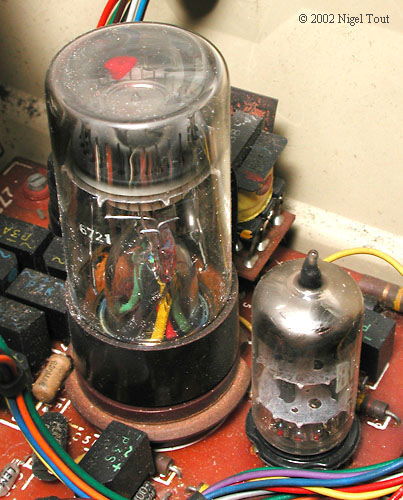
Detail of the keyboard decoder board showing the GS10D "Dekatron" decade counter tube, with a small ECC81 vacuum tube (thermionic valve) to its right, which is part of a blocking oscillator circuit providing driving pulses at a rate of 4000 per second.
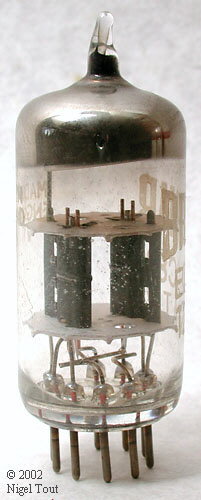
One of the ECC81 double-triode vacuum tubes (thermionic valves) used in the Anita Mk8, with a 9-pin base.
Each of the dark-grey vertical structures contains one triode.
2) Cold-cathode Switching Tubes
In contrast to the vacuum tube which has a hard vacuum and a heated cathode, the cold-cathode switching tube has low-pressure gas inside and has an unheated cathode.
Although the early Anita calculators do use a small number of thermionic valves, the logic circuits incorporate large numbers of Cold Cathode Tubes. In contrast to the thermionic valves the Cold Cathode tubes contain a rarefied inert gas (e.g. neon), and electrons are emitted in an avalanche from the unheated cathode when the voltage between the anode and cathode reaches a high enough value. The flowing current excites the gas inside and produces a glow - this is the way that the small neon mains indicator lamps work. A relatively small voltage on a control grid between the anode and cathode has a great effect on whether a current of electrons flows or not and can switch it on and off.
Cold-cathode trigger tubes operate in a similar way to the modern semiconductor thyristor.
The Anita Mk 8 uses 170 cold-cathode tubes, which were cheap and fairly robust, both electrically and mechanically. An article of 1965 on cold cathode tubes from Mullard Ltd. (a British manufacturer of
these devices who also produced a prototype calculator using them) gives an insight into why they were used in these calculators at the time:
"... They are an accountant's dream; a typical modern tube has a life
expectancy several thousand times better than the conventional thermionic tube, although they employ voltages of the same order. They are much cheaper than either semiconductor devices or vacuum tubes; they do not require costly
materials with a high degree of purity in their manufacture, nor do need transformers or cooling systems to operate. The tubes require no warm-up period and they can take severe overload."
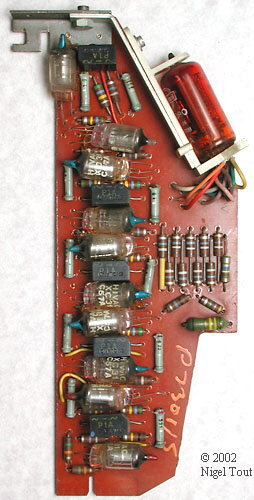
One of the 12 counter/display boards of the Anita Mk 8 with the Nixie-type display tube mounted on the edge. The board holds ten XC-31 cold-cathode switching tubes and 5 black selenium rectifier diode blocks in a ring-counter circuit.
Each switching tube is connected to a number in the display tube, and only one switching tube is turned on at any time. When the board receives a pulse, the next switching tube in the ring counter is turned on and the next number in the display tube is illuminated. If the digit "9" is illuminated and another pulse arrives then the count wraps round the ring so "0" is illuminated and a carry pulse is directed to the adjacent board dealing with the next decade.
The ring-counter circuit can count down as well as up.
Each display board stands vertically and plugs into the main logic board.
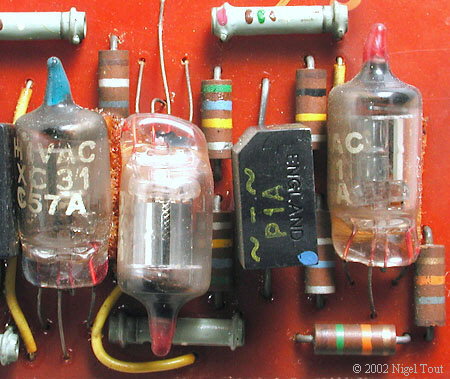
A small section of one of the display/counter boards, showing three Hivac XC31 cold-cathode switching tubes and a selenium rectifier.
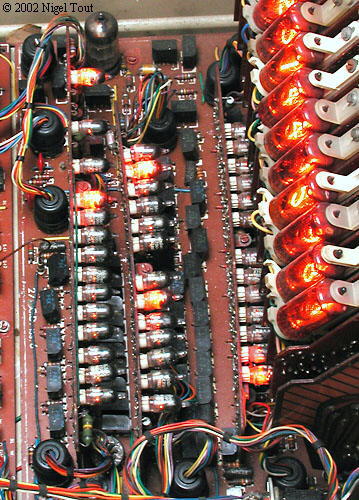
A view of the logic boards of an Anita Mk 8 during operation. The horizontal main board, underneath, carries three vertical daughter boards. The tubes on the daughter boards are cold-cathode switching tubes and the black blocks are selenium rectifier diodes.
When a cold-cathode tube is switched to the ON state it glows orange like a neon lamp, as can be seen in 5 of the tubes on the daughter boards. When the machine calculates the tubes flicker and a different pattern of illuminated switching tubes results.
Dekatron counter tubes contain ten cathodes in a circular array around the anode. With all the cathodes at the same voltage a glow discharge from one of them to the anode will be transferred clockwise to its neighbouring cathode when a pulse is applied to all ten associated guide (transfer) electrodes. Thus ten pulses to the transfer electrodes will return the glow discharge to its original cathode. These tubes were often used against a mask with the digits 0 to 9 so the glow could be seen through the appropriate number.
In the Anita a type of Dekatron, called a Selector tube rather than a Counter tube, is used which has individual connections to each of the ten cathodes. This tube is used to provide "scan" pulses to each row of keys in the keyboard so that value of pressed keys can be decoded.
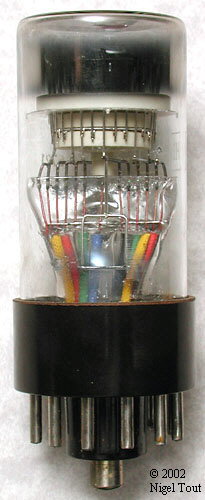
The GS10D "Dekatron" decade selector tube. The wires can be seen leading up to the assembly which supports the circular arrangement of electrodes, which is within the dark area near the top.
The 13-pin base fits into a 12-pin socket, and an extra flying lead with a single socket is used which attaches to the anode centre pin.
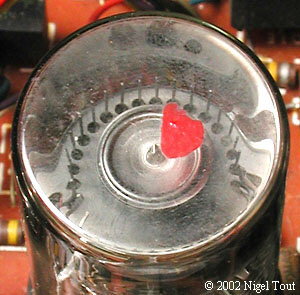
Looking down on the top of the Dekatron. The red mark is a blob of red paint on the top of the tube.
Note that there is a full circle of electrodes, but the distortion through the glass tube has made those at the bottom of the
photograph disappear.
In the centre is the metal circular disk of the anode. Around it is a circular array of thirty vertical electrodes made up of ten cathodes, which are individually wired, ten "First Guides", all connected together, and ten "Second Guides", all connected together.
When a voltage of 400V to 500V is applied between the anode and one of the cathodes, a discharge starts between them, and alters the potential of the cathode. By applying phased pulses to the guide electrodes the discharge is forced to jump from one cathode to the next, and in the process voltage pulses are produced in sequence at the cathodes, which in the early Anita calculators is used for strobing the keys on the keyboard.
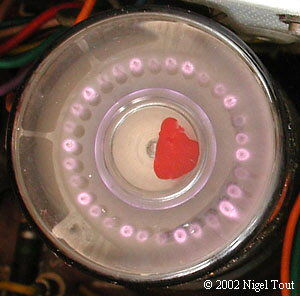
Looking down on the top of the Dekatron during operation. There is a mauve glow around the electrodes as the discharge is passed from one electrode to the next around the assembly.
Note that the glow is brightest at the cathodes, every third electrode, where the discharge sits for the the longest time.
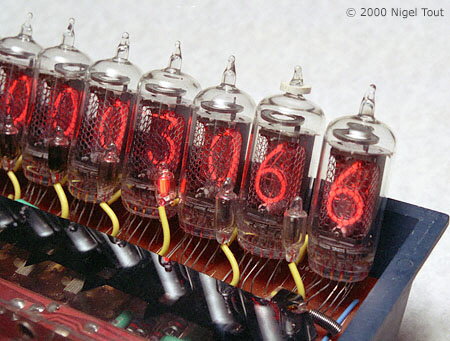
The cold-cathode display tubes of an Anita 1011LSI calculator in use. Note also the small neon lamps used to indicate the decimal point (the third from the right is energised).
The cold-cathode display tube and the neon lamp operate on the same principal.
The simple neon indicator lamp consists of a sealed glass tube with two closely spaced non-heated electrodes, an anode and a cathode. The tube
contains neon gas at very low pressure together with a small percentage of mercury vapour. They are often used in AC power sockets to indicate that they are switched on.
The gas in the tube initially acts as an insulator and as
the voltage between the anode and cathode is increased practically no current flows. However, a little of the gas in the tube will be ionised by naturally occurring cosmic rays, radioactivity, or ambient light into positive ions
and negative electrons. The electric field being applied to the electrodes will cause the positive ions to move towards the cathode and the electrons towards the anode. As the applied voltage is increased so these will start to
move faster and faster, colliding with other gas atoms and ionising them by knocking off electrons.
At the "striking" or "ignition" voltage the ions and electrons move which such high speeds that an avalanche
of further ions and electrons is produced by all the collisions. This leads to a high current flow, which is kept in check by an external resistor in series, and an amber glow at the cathode.
The cold-cathode display tube is a neon lamp with multiple cathodes. Each cathode is shaped like one of the digits 1 to 9, and they are mounted in a closely spaced stack.
In front of the stack is the anode, formed from an open
mesh grid visible in the photograph above. When the striking voltage is applied between the anode grid and any of the cathodes a discharge is formed and the gas around the cathode glows. Since the cathode is shaped like a digit the
glow is also in the shape of that digit - see the photographs.
In use it can be seen that the numbers are in a stack since some numbers appear further forward in the tube than other numbers.
The life performance of a numerical display tube depends to a great extent on the length of time the discharge is maintained on a single cathode (ie. number). This is because in any gas-discharge device the cathode is subjected to
constant ion bombardment which removes material from the cathode and deposits it elsewhere in the tube. This "sputtering" is unavoidable, but is limited by keeping the peak current as low as possible, consistent with
visibility of the display.
If a display tube is kept with one cathode constantly glowing (ie. one number displayed all the time) then material is sputtered from that cathode. This only affects the glow of that cathode a little,
but the sputtered material lands on the other cathodes and affects the current required to make them glow, and can lead to uneven illumination.
If the discharge is cycled between characters regularly, this gives a much improved
life since each cathode, although receiving some sputtered material, is subjected to the cleansing action of bombardment.
The normal figures quoted in published data for the life of a numerical indicator tube is 5,000 hours with
a continuous display of one character, and 30,000 hours when sequentially changing from one digit to the next every 100 hours or less.
Cold-cathode numerical display tubes are often called "Nixie" tubes though this was a trade name of Burroughs Corporation which was an early developer of this technology. Other names used are Pixie tube and Numicator
tube.
For more information see Tom Jenning's "Nixie Indicators and Decimal Counting Tubes" pages at http://fido.wps.com/texts/decimal-tubes/index.html.
Nixie tubes continued to be used in calculators into the early 1970s. The cost of a Burroughs Nixie tube in 1971 was about $2 for lots of 10,000, which made them very competitive. However their size and high power and voltage requirements were disadvantages.
The Bell Punch Company & the Development of the Anita Calculator
< Previous page Next page >
Text & photographs copyright © 2002 - 2023 Nigel Tout, except where noted otherwise.